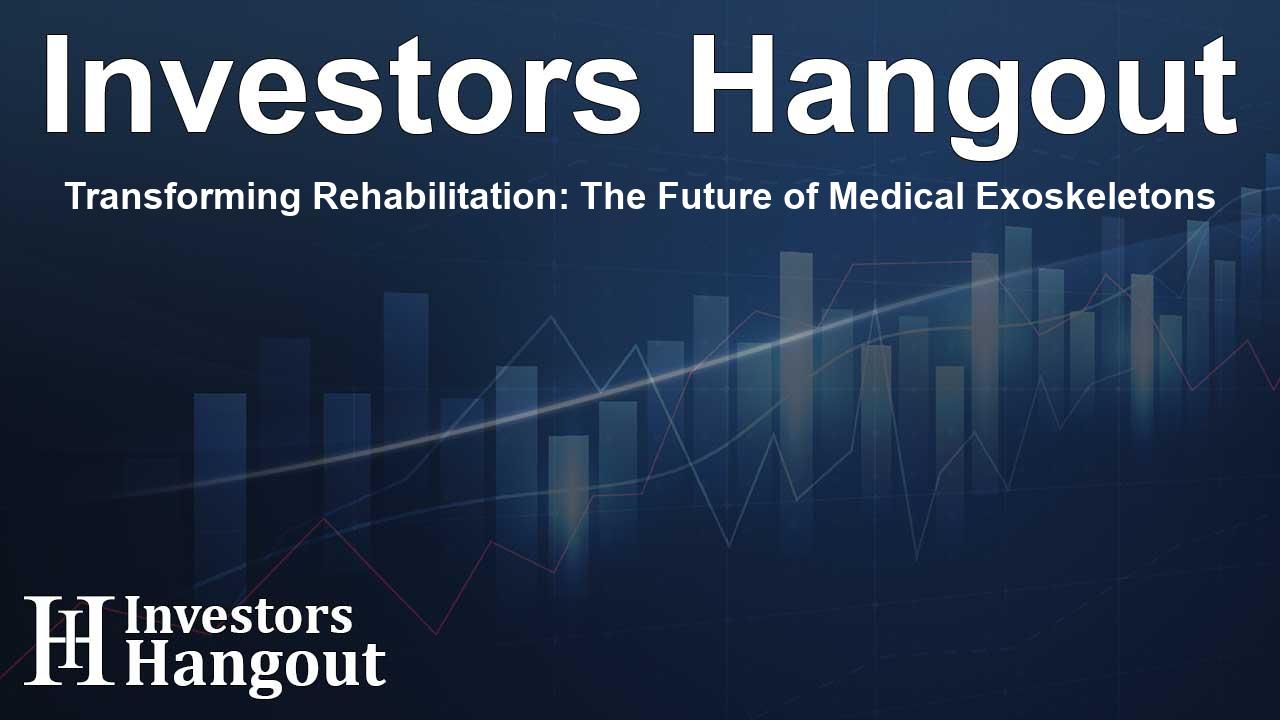Transforming Rehabilitation: The Future of Medical Exoskeletons

Explosive Growth in the Medical Exoskeleton Market
The global medical exoskeleton market is experiencing remarkable growth, projected to reach a value increase of USD 2.87 billion during the upcoming period from 2024 to 2028. A crucial driving force behind this surge is the rising number of spinal cord injury (SCI) cases, coupled with advancements in artificial intelligence (AI) that are reshaping the landscape of rehabilitation technology. Industry analysts highlight that the market is anticipated to grow at a compound annual growth rate (CAGR) of approximately 55.77% within this timeframe.
Advancements in Rehabilitation Technology
Medical exoskeletons play a vital role in changing rehabilitation strategies aimed at individuals suffering from strokes, severe musculoskeletal injuries, and neurological disorders. Leaders in the market, such as Ekso Bionics and ReWalk Robotics, are at the forefront with their innovative self-assist devices that greatly enhance mobility. These sophisticated exoskeletons are designed not only to assist in physical rehabilitation but also to improve the overall quality of life for users.
The Role of AI in Market Evolution
Artificial intelligence is powering significant changes in the medical exoskeleton market. By integrating smart technologies, these devices are becoming more adaptive to users' needs, providing tailored support that allows individuals to recover mobility effectively. Through predictive algorithms and data analytics, AI is enhancing the functionality of exoskeletons, making them more efficient and user-friendly.
Market Challenges Ahead
Despite the promising growth trajectory, the market does face challenges. A key issue is the need for well-trained caregivers who can effectively operate and support patients utilizing exoskeletons during therapy. The inconsistency in training programs and the requirement for precise coordination between caregivers and patients are hurdles that need to be addressed. Ensuring that caregivers are adequately trained is essential for maximizing the benefits of these advanced devices.
Current Market Trends and Innovations
Several trends are currently shaping the medical exoskeleton market. There’s a notable increase in the introduction of lighter, more user-friendly devices that make rehabilitation more accessible. For instance, the recent launch of devices such as SUITX by Ottobock and advanced offerings from German Bionic shows improved designs, greater adjustability, and enhanced durability. This trend towards innovation is expected to significantly fuel market expansion over the forecast period.
Overview of Key Market Segments
The medical exoskeleton market can be segmented by mobility type, technology, and geography. Mobility types include mobile exoskeletons designed for homecare use and stationary exoskeletons primarily intended for rehabilitation facilities. When considering technology, the market consists of powered and passive exoskeletons that serve different rehabilitation needs. Regions such as North America, Europe, and Asia are leading in terms of market presence, while opportunities continue to grow in other parts of the world.
Conclusion: The Future of Rehabilitation Technology
In summary, the medical exoskeleton market stands at the intersection of technological innovation and healthcare needs, promising to provide revolutionary solutions for individuals with mobility impairments. Companies like Ekso Bionics and ReWalk Robotics are crucial players, driving advancements that improve mobility and independence for those affected by various conditions. The ongoing integration of AI into these technologies is not just a trend but a necessary evolution to meet the growing demand for effective rehabilitation solutions.
Frequently Asked Questions
What is the growth forecast for the medical exoskeleton market?
The medical exoskeleton market is expected to grow by USD 2.87 billion between 2024 and 2028.
How is AI influencing the medical exoskeleton market?
AI is enhancing the adaptability and efficiency of medical exoskeletons, allowing for personalized rehabilitation experiences.
What are the main challenges in the market?
Challenges include the scarcity of trained caregivers and the need for standardized training programs for effective device operation.
Who are the key players in the medical exoskeleton market?
Key players include Ekso Bionics, ReWalk Robotics, BIONIK, and several others leading the development of innovative solutions.
What segments are included in the medical exoskeleton market?
The market is segmented by mobility type, technology, and geographical regions, targeting specific rehabilitation needs and locations.
About Investors Hangout
Investors Hangout is a leading online stock forum for financial discussion and learning, offering a wide range of free tools and resources. It draws in traders of all levels, who exchange market knowledge, investigate trading tactics, and keep an eye on industry developments in real time. Featuring financial articles, stock message boards, quotes, charts, company profiles, and live news updates. Through cooperative learning and a wealth of informational resources, it helps users from novices creating their first portfolios to experts honing their techniques. Join Investors Hangout today: https://investorshangout.com/
Disclaimer: The content of this article is solely for general informational purposes only; it does not represent legal, financial, or investment advice. Investors Hangout does not offer financial advice; the author is not a licensed financial advisor. Consult a qualified advisor before making any financial or investment decisions based on this article. The author's interpretation of publicly available data shapes the opinions presented here; as a result, they should not be taken as advice to purchase, sell, or hold any securities mentioned or any other investments. The author does not guarantee the accuracy, completeness, or timeliness of any material, providing it "as is." Information and market conditions may change; past performance is not indicative of future outcomes. If any of the material offered here is inaccurate, please contact us for corrections.